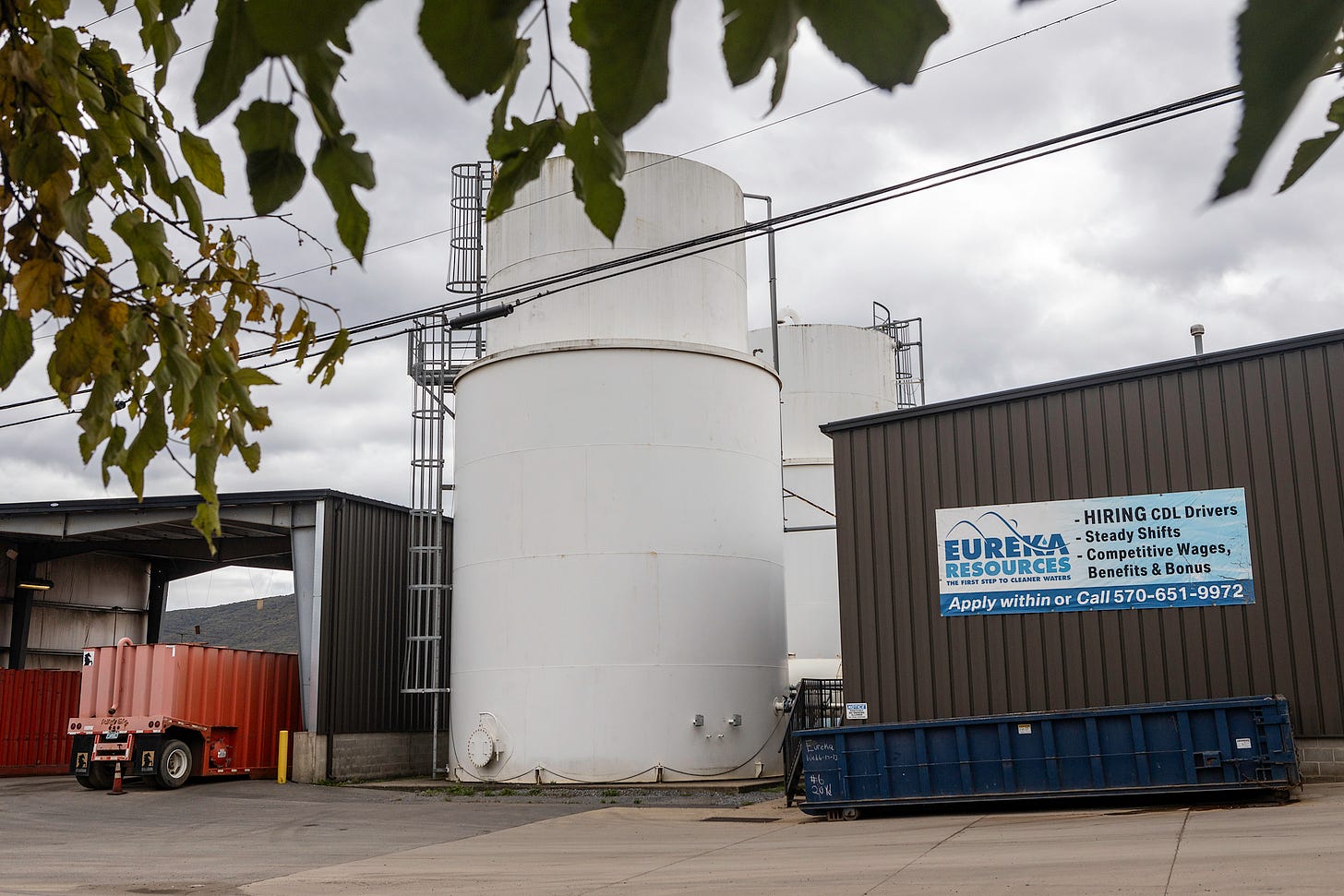DEP Releases Update on Eureka Resources — Fails To Use The "Right Test" For Radiation
Eureka Resources 2nd Street Plant – 419 2nd
Street, Williamsport, Pennsylvania. © Steven Rubin for Public Herald
DEP has sent the following update about Eureka Resources spill into the West Fork of the Susquehanna to Public Herald, which included 8 documents:
“DEP has continued its investigation following the spill from an aboveground storage tank at Eureka Resources’ 2nd Street Williamsport facility on August 17, 2025. DEP has inspected the facility daily since the spill occurred (see attached inspection reports). DEP is working closely with the PA Fish and Boat Commission, Williamsport Sanitary Authority, Lycoming County Emergency Management Agency, City of Williamsport, and Williamsport Fire Department. DEP will explore all options and resources for carrying out cleanup efforts, which will continue as long as necessary. To prevent additional releases to the river, the ongoing cleanup efforts are currently focused on the Eureka facility and the connected stormwater system to remove any remaining pooled material.
Representatives from DEP’s Waste Management program have taken samples from the site, including of the spilled material, and in the river above and below the point of discharge to be tested for constituents of petroleum products and radioactive material. A member of DEP’s Emergency Response Team used an AccuRad radiations meter to survey radiation at the site of the spill during the initial investigation response, and did not detect any levels of radiation above background levels. The closest downstream public water supplier in Milton has been monitoring its intake and has reported no impacts. Based on all available information, DEP determined it was not necessary to recommend a broad-based restriction on public access to the river.
On Tuesday, August 19, 2025, DEP issued an Administrative Order (attached) to Eureka Resources ordering them to take immediate interim action to prevent further release from the leaking tank at the 2nd Street Williamsport facility, to submit to DEP within five days a plan to remove all liquid waste spilled at the site, and to remove all liquid waste currently stored at the site within 30 days. DEP found that as of June 29, 2025, the waste had been stored for over one year, placing it in violation of the permit.
DEP has been closely monitoring the status of all three of Eureka Resources’ facilities and has taken several actions as materials stored at the various sites began to exceed the one-year threshold of waste being stored on site. On July 9, 2025, DEP issued an Administrative Order and Assessment of Civil Penalty for the Catawissa Avenue (aka Reach Road) Williamsport facility (see attached materials). DEP also continues to work through a similar enforcement process for the Standing Stone Bradford County facility.”
Public Herald will continue to report on this story in the coming week and address the issues raised by DEP in this udpate. For now, it’s important for us to point out that the state has again relied on the wrong testing for radiation regarding radium-226 — an isotope with the highest levels of detection in fracking wastewater.
Public Herald investigations have shown that while the DEP may test or monitor leachate coming out of facilities handling TENORM and affected groundwater, the type of testing used at landfills or sewage plants to monitor for ‘hot’ loads of waste isn’t capable of producing accurate measurements for radium unless it’s measuring with gamma spectroscopy in a minimum 21 day window. In this case, trying to determine the dangerous levels of radium-226 in an instant wouldn’t be possible.
When we told Dr. Julie Weatherington-Rice, a soil scientist and adjunct professor for Ohio State University, about DEP’s type of testing, specifically for tracking TENORM at landfills, she said, “Pennsylvania is counting on smoke and mirrors for protection because they’re not using the right test and they’re not using the right equipment. They don’t know what they put in that landfill. They think they do, but they don’t.”
In the case of the West Fork of the Susquehanna River, DEP again, at least from what we currently know, has failed to use the right test.
Two detectors described in the guidance — geiger-muller counters and zinc sulfide scintillation detectors — can be used to detect beta, gamma and alpha decay radiation in oil and gas waste, but the testing emphasis is placed on gamma radiation.
Pennsylvania is relying on a system that tries to quickly detect levels of gamma, whereas radium is emitting high levels of alpha. According to experts like Dr. Weatherington-Rice, the only way to accurately detect alpha-emitting radioactivity levels is with a different system of testing that landfills, sewage plants, DEP, and oil and gas industry representatives are not required to perform.
The DEP admits difficulties with alpha testing. Geiger-muller counter probes must be held close to the surface of the material because “instruments cannot detect alpha radiation through even a thin layer of water, dust, paper, or other material,” and using scintillation detectors to monitor alpha emission “is often conducted in laboratories rather than field settings.” Additionally, non-zinc sulfide scintillation detectors cannot be used to read alpha emissions.
Andrew Gross, the former head of an oil & gas radioactivity company, called Pennsylvania the regulatory “Wild West.”
“Pennsylvania is definitely the Wild West when it comes to radiological health regulations — I’ve never seen anything like it,” said Gross. “And for me, especially being a guy from Louisiana, that really strikes me as odd, that we’re so much better off down here than all the people who are so smart up there.”
Review all 8 documents from DEP about Eureka Resources spill »
Public Herald will be releasing an updated report about what these documents share in the coming week. Stay tuned.
Embed documents for your website using code:
<iframe src="https://embed.documentcloud.org/projects/222416-eureka-update-082225/?embed=1" width="100%" height="600px"></iframe>


